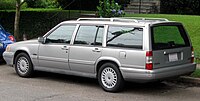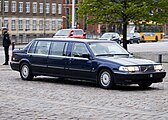Volvo 900 series
| Volvo | |
|---|---|
|
Volvo 940 (1990-1994)
|
|
| 940/960 / S90 / V90 | |
| Production period: | 1990-1998 |
| Class : | upper middle class |
| Body versions : | Limousine , station wagon |
| Engines: |
Otto engines : 2.0–3.0 liters (82–150 kW) Diesel engines : 2.4 liters (60–90 kW) |
| Length: | 4840-4871 mm |
| Width: | 1750 mm |
| Height: | 1410 mm |
| Wheelbase : | 2770 mm |
| Empty weight : | 1370-1600 kg |
| Previous model | Volvo 740 / 760 |
| successor | Volvo S80 |
The Volvo 900 series refers to a number of passenger car models from the Swedish car manufacturer Volvo , which belong to the upper middle class and were manufactured from summer 1990 to spring 1998.
Type designation
The 900 series initially comprised the vehicle types 940 and 960 .
The designations usually stand for the number of cylinders in the engine (940: four-cylinder; 960: six-cylinder).
At the end of 1996, Volvo changed the sales names of its models: from then on the station wagons were designated as “V” (for versatility), the sedans as “S” (for sedan). The following two-digit number stands for the series (e.g. S40 , V70 ). The 960 sedan became the S90, the 960 station wagon the V90. However, there are also vehicles that were built during the 1997 model year but still bear the type designation 960.
The S90 / V90 can be distinguished from the 964/965 on the basis of small things, e.g. B. by the arrangement of the seat heating switch. These are no longer arranged one behind the other in the direction of travel, but are located on the left and right in front of the automatic selector lever.
The 940 was not affected by the change in type designation. It was sold under its previous name until the end of production. In Italy it was offered under the name "Polar". In Switzerland and the Benelux countries, “Polar” was the name given to an equipment line for the Volvo 940.
Model history
The 900 series was introduced in autumn 1990 as a further development of the 700 series and replaced it completely in late summer 1992.
The 960s were largely identical to the 940s, but had more extensive equipment and were always equipped with the most powerful engines intended for the respective market, with the 2.3-liter turbo petrol and 2.4-liter turbo Diesel were not available in Germany . In addition, the 960 sedans were equipped with an elaborate multi-link rear axle Multilink I , while the station wagons like the 940s retained the rigid axle.
In the summer of 1994, a stronger visual differentiation was made between the 940 and 960 series. The changes were so extensive, u. a. there was a completely changed, more aerodynamic front section, so that the 960s in question are also referred to as "960 II".
At that time, the 960 series also received a completely redesigned multi-link rear axle Multilink II with a transverse leaf spring made of glass fiber reinforced plastic , additional springs and shock absorbers with automatic level control . This rear axle was used in both the sedan and the station wagon.
A total of around 670,000 vehicles of the 900 series were built, including around 390,000 sedans and almost 280,000 station wagons. In addition, Volvo produced a small number of the 960 Pullman / S90 Pullman as a representative vehicle.
Based on the Volvo S90, Volvo built 15 cm longer versions. These were then marketed and sold as the Volvo S90 Executive Royale. There were three types in total. Level I, II and the most luxurious level III. The latter offered the passengers individually adjustable seats, drink coolers, individually controllable air conditioning and control of the sound system via remote control. All these versions were provided with extra wood around the dashboard and lettering.
While the 940 sedan was withdrawn from the German market before production was discontinued, the station wagon was available until the end of the series. When production of the 900 series was discontinued in the spring of 1998, the era of rear-wheel drive ended at Volvo .
940 "Classic"
In the last few months of the model life, Volvo offered a special model under the designation 940 "Classic" in some countries, including Germany. The Classic models came standard with some things that were previously optional extras. These included u. a. ABS, additional airbags, manual air conditioning, suede leather, electric windows and electrically adjustable and heated exterior mirrors. Externally, the Classic models can be identified by the white instead of orange-white lenses for the indicators and parking lights. Modified bumpers were also used, the top of which is covered with a strip painted in body color. In addition, a trim strip painted in body color was added to the rear side panels of the estate models between the rear wheel arch and the taillights. This change also required slightly modified taillight clusters.
technology
The 960 sedans were with a sophisticated multi-link rear suspension called Multilink I equipped. This axle had also been used in the sedans of the Volvo 760. The 940 sedan and all station wagons with the exception of the 960-II (this had a Multilink-II rear axle ) were equipped with a rigid rear axle , which is less maintenance-intensive and, thanks to its track and camber constancy, shows good-natured, but only conditionally comfortable handling . Because of the good rust protection and the robust engines, problems with the chassis are most likely to become noticeable in old age. Worn tie rod ends and worn steering gears are often affected .
As with the 700 series, the 900 series also had a wheelbase of 2,770 millimeters. The external length varies between 4844 and 4871 millimeters, depending on the version. There were also the versions 960 Executive and S90 Executive . These are limousines with an extended wheelbase and a total length of over 5 meters. There are also special vehicles based on the 900 series, e.g. B. Ambulances and hearses. The curb weight is between 1327 and 1710 kilograms. The permitted braked trailer load is a maximum of 2.0 tons. Due to the characteristic hatchback, the space available in the estate versions with a load volume of up to 2200 liters offers values that most competitors have not yet achieved. Due to the use of numerous galvanized sheet metal for the body, the very good workmanship of the body, extensive use of cavity preservation and underbody protection and numerous aluminum components such as the bonnet on the 960 and the tailgate on the 945 and 965, the vehicles are well protected against rust.
Most of the engines were adopted from the 200 and 700 series and revised for the 900 series. Although the in- line four-cylinder units are very robust, even in this generation they are not considered the strength of the vehicles. They run rough, rev up rather unwillingly and consume a comparatively high amount of fuel. Even with the basic engine, the vehicle can hardly be moved under 10 liters per 100 kilometers, the turbo quickly exceeds 13 liters.
The gasoline six-cylinder in-line engine was specially developed for the 960. This replaced the Euro V6 PRV engine that had been introduced with the Volvo 264 . The Porsche development center in Weissach was commissioned to develop the engine. It formed the basis for a modular system from which the petrol five-cylinder in-line engines of the Volvo 850, S / V / C70 and S80 emerged (but also the four-cylinder engines, e.g. in the S / V40). As a special feature, these engines have individual ignition coils, air-gap-insulated Y-pipes and a 6-in-2-in-1 exhaust system. The cylinder head and block are made of aluminum, with the block having cast-in cylinders made of gray cast iron. The 3.0i engine with 150 kW / 204 PS was only available in combination with a four-speed automatic transmission, the 132 kW version and the 2.5i engine also with a manual five-speed transmission.
From model year 1993, the so-called SIPS system was introduced in all vehicles of the 900 series in addition to the already existing impact protection tubes in all four doors to improve safety in the event of side collisions . This consists of special reinforcements for the roof, the floor pan, the B-pillars and cross struts in the front seats. Special upholstery in the doors directs the impact energy to the struts in the seats in order to preserve the survival space in the vehicle. In later model years, the B-pillar was reinforced and side airbags were also introduced in the seats.
Volvo 940
Four-cylinder in- line engine (gasoline engine) (aluminum head; cast iron block; one overhead camshaft via toothed belt ; 2 or 4 valves per cylinder; all with controlled three-way catalytic converter )
- 2.0i (82 kW / 112 PS); Designation: B200F
- 2.0i Turbo (114 kW / 155 PS); Designation: B200FT, not officially offered in Germany
- 2.3i (85 kW / 116 hp); Designation: B230F, not officially offered in Germany
- 2.3i (96 kW / 131 PS); Designation: B230FB
- 2.3i low pressure turbo (99 kW / 135 PS); Designation: B230FK
- 2.3i DOHC 16v (114 kW / 155 PS); Designation: B234F
- 2.3i Turbo or Turbo Intercooler (121 kW / 165 PS); Designation: B230FT
Six-cylinder in-line engine (diesel) (from VW ; aluminum head; cast iron block; an overhead camshaft over a toothed belt; 2 valves per cylinder; later with an oxidation catalyst )
- 2.4 Diesel (60 kW / 82 PS)
- 2.4 turbo diesel (80 kW / 109 PS)
- 2.4 Turbo-Diesel Intercooler (85 kW / 115 PS) until 1993
- 2.4 Turbo-Diesel Intercooler (90 kW / 122 PS) from 1992
Volvo 960 I.
Built from August 1990 to July 1994
Four-cylinder in-line engine (gasoline engine) (aluminum head; cast iron block; one overhead camshaft via toothed belt; 2 or 4 valves per cylinder; all with controlled three-way catalytic converter)
- 2.0i Turbo DOHC 16v (140 kW / 190 PS)
- 2.3i Turbo (115 kW / 156 PS)
Six-cylinder in-line engine (petrol) (aluminum head; aluminum block: two overhead camshafts via toothed belt; 4 valves per cylinder; regulated three-way catalytic converter)
- 3.0i (150 kW / 204 PS)
Six-cylinder in-line engine (diesel) (from VW; aluminum head; cast iron block; an overhead camshaft over a toothed belt; 2 valves per cylinder; later with an oxidation catalyst)
- 2.4 Turbo-Diesel Intercooler (90 kW / 122 PS)
Volvo 960 II
Built from July 1994 to November 1996, for Germany
Six-cylinder in-line engine (petrol) (aluminum head; aluminum block: two overhead camshafts via toothed belt; 4 valves per cylinder; regulated three-way catalytic converter)
- 2.5i (121 kW / 170 hp)
- 3.0i (150 kW / 204 PS)
Volvo S90 / V90
Built from November 1996 to April 1998, for Germany
Six-cylinder in-line engine (petrol) (aluminum head; aluminum block: two overhead camshafts via toothed belt; 4 valves per cylinder; regulated three-way catalytic converter)
- 3.0i (132 kW / 180 PS)
- 3.0i (150 kW / 204 PS)
Web links
Individual evidence
- ↑ Classics can be collected. (PDF) In: Volvo sales brochure. Retrieved March 12, 2019 .
- ↑ a b Matti A. Bohm: The last fortress. In: Oldtimer Praxis , issue 12/2017, pp. 18–21.













